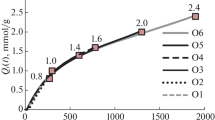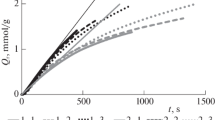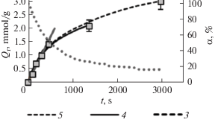Abstract
Lignocellulose materials (LCMs) obtained after treatment of aspen (Populus tremula) wood with ozone were studied by diffuse reflectance UV spectroscopy, Raman spectroscopy, and fluorescence spectroscopy. The destruction of lignin (LG) proved most effective in the range of specific ozone consumptions of ≤1.5 mmol/g at ≥50% conversion of ozone. The destruction of syringyl and stilbene structures and other systems of conjugated double bonds of LG with ozone was highly efficient. Delignification of LCMs was accompanied by a multiple increase in the intensity of fluorescence (FL). The FL intensity was correlated with the fraction of LG destroyed by ozone. It was shown that wood treatment with ozone makes it possible to vary the luminescence spectral characteristics of LCMs, and fluorescence spectroscopy can be considered to be one of the most sensitive methods for monitoring the ozonolytic delignification of wood.







Similar content being viewed by others
REFERENCES
K. G. Bogolitsyn, Ros. Khim. Zh. (Zh. Ros. Khim. Ob-va im. D. I. Mendeleeva) 48 (6), 105 (2004).
Physical Chemistry of Lignin, Ed. by K. G. Bogolitsyn and V. V. Lunin (Arkhang. Gos. Tekh. Univ., Arkhangel’sk, 2009) [in Russian].
V. G. Samoilovich, S. N. Tkachenko, I. S. Tkachenko, and V. V. Lunin, Theory and Practice of Obtaining and Using Ozone, Ed. by V. V. Lunin (Mosk. Gos. Univ., Moscow, 2016) [in Russian].
N. A. Mamleeva, E. M. Ben’ko, and V. V. Lunin, Methods for the Neutralization of Wastewater, Gas Emissions and Waste from Production and Consumption, Ed. by V. V. Lunin (Mosk. Gos. Univ., Moscow, 2019) [in Russian].
M. M. Ksenofontova, A. N. Mitrofanova, N. A. Mamleeva, A. N. Pryakhin, and V. V. Lunin, Ozone: Sci. Eng. 25, 505 (2003).
T. Eriksson and J. Gierer, in Proceedings of the International Symposium on Wood and Pulping Chemistry (Tappi and ISWPC, Tsukuba Science City, Japan, 1983), Vol. 4, p. 94.
A. G. Khudoshin, Cand. Sci. (Chem.) Dissertation (Moscow State Univ., Moscow, 2008).
B. Ferron, J. P. Croué, and M. Dore, Ozone: Sci. Eng. 17, 687 (1995). https://doi.org/10.1080/01919512.1995/10555779
C. Li, L. Wang, Z. Chen, Y. Li, et al., Biores. Technol. 183, 240 (2015).
E. V. Benko, D. G. Chukhchin, and V. V. Lunin, Holzforschung (2020). https://doi.org/10.1515/hf-2019-0168
Y. Rosen, H. Mamane, and Y. Gerchman, Bioenergy Res. 12, 292 (2019). https://doi.org/10.1007/s12155-019-9962-3
C. Olkkonen, Y. Tylli, I. Forsskåhl, et al., Holzforschung 54, 397 (2000).
N. A. Mamleeva, S. A. Autlov, N. G. Bazarnova, and V. V. Lunin, Russ. J. Bioorg. Chem. 42, 694 (2016). https://doi.org/10.1134/S1068162016070098
N. A. Mamleeva, A. N. Kharlanov, D. G. Chukhchin, N. G. Bazarnova, and V. V. Lunin, Russ. J. Bioorg. Chem. 46, 1330 (2020). https://doi.org/10.1134/S1068162020070080
N. A. Mamleeva, A. N. Kharlanov, S. Yu. Kupreenko, and D. G. Chukhchin, Russ. J. Phys. Chem. A 95, 2214 (2021).
N. A. Mamleeva, A. V. Shumyantsev, and A. N. Kharlanov, Russ. J. Phys. Chem. A 95, 682 (2021).
N. A. Mamleeva, E. M. Ben’ko, A. N. Kharlanov, A. V. Shumyantsev and D. G. Chukhchin, Russ. J. Phys. Chem. A 95, 577 (2021).
N. A. Mamleeva, A. N. Kharlanov, and V. V. Lunin, Russ. J. Phys. Chem. A 93, 2550 (2019).
N. A. Mamleeva, A. N. Kharlanov, and V. V. Lunin, Russ. J. Phys. Chem. A 94, 1780 (2020).
U. P. Agarwal, Front. Plant Sci. 5, 490 (2014). https://doi.org/10.3389/fpls.2014.00490
Zh. Ji, J. Ma, and F. Xu, Microsc. Microanal. 20, 566 (2014).
M. Kihara, M. Takayama, H. Wariishi, and H. Tanaka, Spectrochim. Acta, Part A 58, 2211 (2002).
J. S. Lupoi, S. Singh, R. Parthasarathi, et al., Renewable Sustainable Energy Rev. 49, 871 (2015).
E. Billa, E. Koutsoula, and E. G. Koukios, Bioresource Technol. 67, 25 (1999).
A. N. Zakazov and E. I. Chupka, Khim. Drev., No. 2, 52 (1983).
L. Donaldson, IAWA J. 34 (2013).
E. I. Chupka and V. M. Burlakov, Khim. Drev., No. 2, 31 (1984).
B. Albinsson, S. Li, K. Lundquist, and R. Stomberg, J. Mol. Struct. 508, 19 (1999).
K. Radotić, A. Kalauzi, D. Djikanović, et al., J. Photochem. Photobiol. B 83, 1 (2006). https://doi.org/10.1016/j.jphotobiol.2005.12.001
M. V. Panfilova, D. S. Kosyakov, and K. G. Bogolitsyn, in Proceedings of the Europe Workshop on Lignocelulosics and Pulp. EWLP, Seville, Spain, June 24–27, 2014, p. 627.
M. V. Kuznetsova, D. S. Kosyakov, N. S. Gorbova, and K. G. Bogolitsyn, Russ. J. Phys. Chem. A 94, 1587 (2020).
A. V. Obolenskaya, Z. P. El’nitskaya, and A. A. Leonovich, in Laboratory Work on the Chemistry of Wood and Cellulose (Ekologiya, Moscow, 1991) [in Russian].
S. D. Razumovskii, Ozone and Its Reactions with Organic Compounds (Nauka, Moscow, 1974), p. 219 [in Russian].
Funding
This study was performed using the equipment of the Nanochemistry and Nanomaterials Multiaccess Center at the Faculty of Chemistry, Moscow State University, and financially supported by the Ministry of Education and S-cience of the Russian Federation within the framework of the state-budget-supported topic “Physical chemistry of the surface. Adsorption and catalysis” АААА-А21-121011990019-4 (Ozonolytic Delignification of LCMs: UV and Raman Spectroscopy) and also using the equipment of the Arctic Multiaccess Center of the Northern (Arctic) Federal University under the government contract (project no. 121112300066-3 (Study of the Luminescence Characteristics of Wood)).
Author information
Authors and Affiliations
Corresponding author
Ethics declarations
The authors declare that they have no conflicts of interest.
Additional information
Translated by L. Smolina
Rights and permissions
About this article
Cite this article
Mamleeva, N.A., Kharlanov, A.N., Kuznetsova, M.V. et al. Delignification of Wood of Populus tremula by Treatment with Ozone. Russ. J. Phys. Chem. 96, 2043–2052 (2022). https://doi.org/10.1134/S0036024422090229
Received:
Revised:
Accepted:
Published:
Issue Date:
DOI: https://doi.org/10.1134/S0036024422090229




